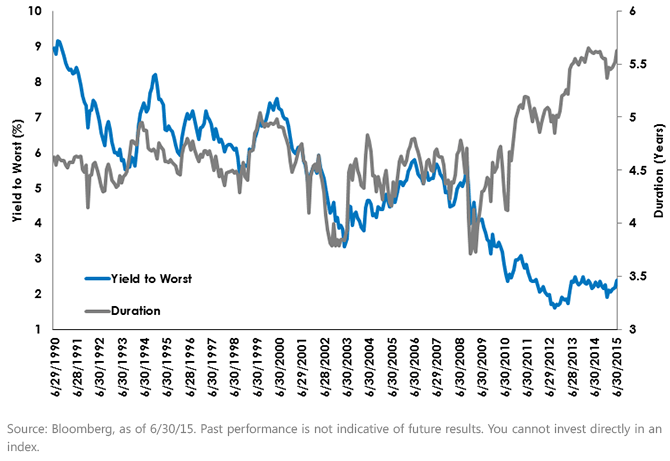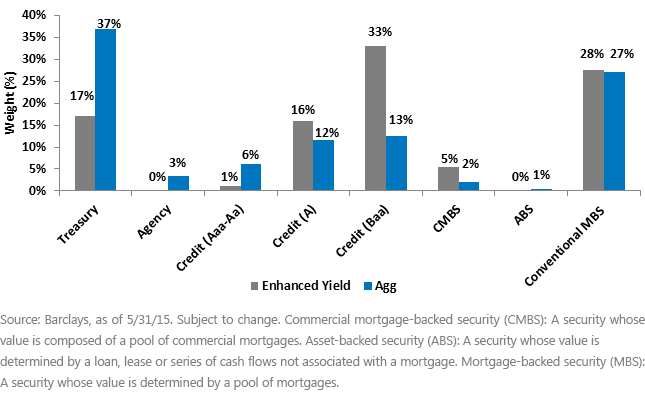Enhancing Income Potential of the Barclays U.S. Aggregate Index


 For definitions of terms in the chart, visit our glossary.
Market Presence May ≠ Best Value in Fixed Income
As we have long asserted, the construction of the Agg and other market capitalization-weighted benchmarks reflects issuance, not necessarily value. As a result, issuance patterns dictate sector, duration and credit tilts that are detached from a bond investor’s desire for consistent income. For example, the current composition of the Agg is over-weight U.S. Treasury securities; in fact, nearly 23% of the Agg is composed of Treasuries maturing in fewer than five years. Thus the largest sector within the Agg is concentrated in securities yielding less than 1%.2
With these potential challenges in mind, WisdomTree worked with Barclays to develop a framework that enhances the income potential of the Agg while retaining its broad volatility profile of a balanced portfolio.
Barclays U.S. Aggregate Enhanced Yield Index
In response to the low income and increasing duration risk discussed above, many investors have sought to increase the income potential of their portfolios by investing in securities outside the Agg. While we currently favor credit risk over interest rate risk, increasing exposure to non-investment-grade debt introduces new sources of volatility. As an alternative, we believe additional income potential can be secured by building from within the constituents of the Agg.
The enhanced-yield Index is constructed by separating the Agg into 20 components and then reweighting the exposures to maximize yield while adhering to certain constraints. Absent these guardrails, the Index would simply be over-weight credit and duration. The output, as shown below, results in greater weights to the higher-yielding segments of the market, while under-weighting the lower-yielding U.S. government allocations in the Agg.
Enhanced Yield vs. Agg Relative Sector Exposure
For definitions of terms in the chart, visit our glossary.
Market Presence May ≠ Best Value in Fixed Income
As we have long asserted, the construction of the Agg and other market capitalization-weighted benchmarks reflects issuance, not necessarily value. As a result, issuance patterns dictate sector, duration and credit tilts that are detached from a bond investor’s desire for consistent income. For example, the current composition of the Agg is over-weight U.S. Treasury securities; in fact, nearly 23% of the Agg is composed of Treasuries maturing in fewer than five years. Thus the largest sector within the Agg is concentrated in securities yielding less than 1%.2
With these potential challenges in mind, WisdomTree worked with Barclays to develop a framework that enhances the income potential of the Agg while retaining its broad volatility profile of a balanced portfolio.
Barclays U.S. Aggregate Enhanced Yield Index
In response to the low income and increasing duration risk discussed above, many investors have sought to increase the income potential of their portfolios by investing in securities outside the Agg. While we currently favor credit risk over interest rate risk, increasing exposure to non-investment-grade debt introduces new sources of volatility. As an alternative, we believe additional income potential can be secured by building from within the constituents of the Agg.
The enhanced-yield Index is constructed by separating the Agg into 20 components and then reweighting the exposures to maximize yield while adhering to certain constraints. Absent these guardrails, the Index would simply be over-weight credit and duration. The output, as shown below, results in greater weights to the higher-yielding segments of the market, while under-weighting the lower-yielding U.S. government allocations in the Agg.
Enhanced Yield vs. Agg Relative Sector Exposure
 As a result, the yield-enhanced Index delivers an additional 70 basis points (bps) of yield compared to the aggregate with a similar volatility profile.3 In our view, this mechanical approach enhances the desirable characteristics of the Agg, while also enhancing the income potential of the strategy. For investors needing to hit minimum income targets, this modification of the Agg could help them achieve their objectives. For managers concerned about the high-yield bond market, this approach also provides higher income potential in an all-investment-grade portfolio.
In today’s uncertain market environment, investors are increasingly looking for ways to enhance the income potential of their portfolios. Through its yield-enhanced approach, WisdomTree seeks to maintain the key characteristics of a popular investment strategy while enhancing its income profile.
1Source: Barclays, as of 6/30/15.
2Sources: Barclays, WisdomTree, as of 6/30/15.
3Source: Barclays, as of 5/31/15.
As a result, the yield-enhanced Index delivers an additional 70 basis points (bps) of yield compared to the aggregate with a similar volatility profile.3 In our view, this mechanical approach enhances the desirable characteristics of the Agg, while also enhancing the income potential of the strategy. For investors needing to hit minimum income targets, this modification of the Agg could help them achieve their objectives. For managers concerned about the high-yield bond market, this approach also provides higher income potential in an all-investment-grade portfolio.
In today’s uncertain market environment, investors are increasingly looking for ways to enhance the income potential of their portfolios. Through its yield-enhanced approach, WisdomTree seeks to maintain the key characteristics of a popular investment strategy while enhancing its income profile.
1Source: Barclays, as of 6/30/15.
2Sources: Barclays, WisdomTree, as of 6/30/15.
3Source: Barclays, as of 5/31/15.Important Risks Related to this Article
Fixed income investments are subject to interest rate risk; their value will normally decline as interest rates rise. Fixed income investments are also subject to credit risk, the risk that the issuer of a bond will fail to pay interest and principal in a timely manner or that negative perceptions of the issuer’s ability to make such payments will cause the price of that bond to decline. Investing in mortgage- and asset-backed securities involves interest rate, credit, valuation, extension and liquidity risks and the risk that payments on the underlying assets are delayed, prepaid, subordinated or defaulted on.


